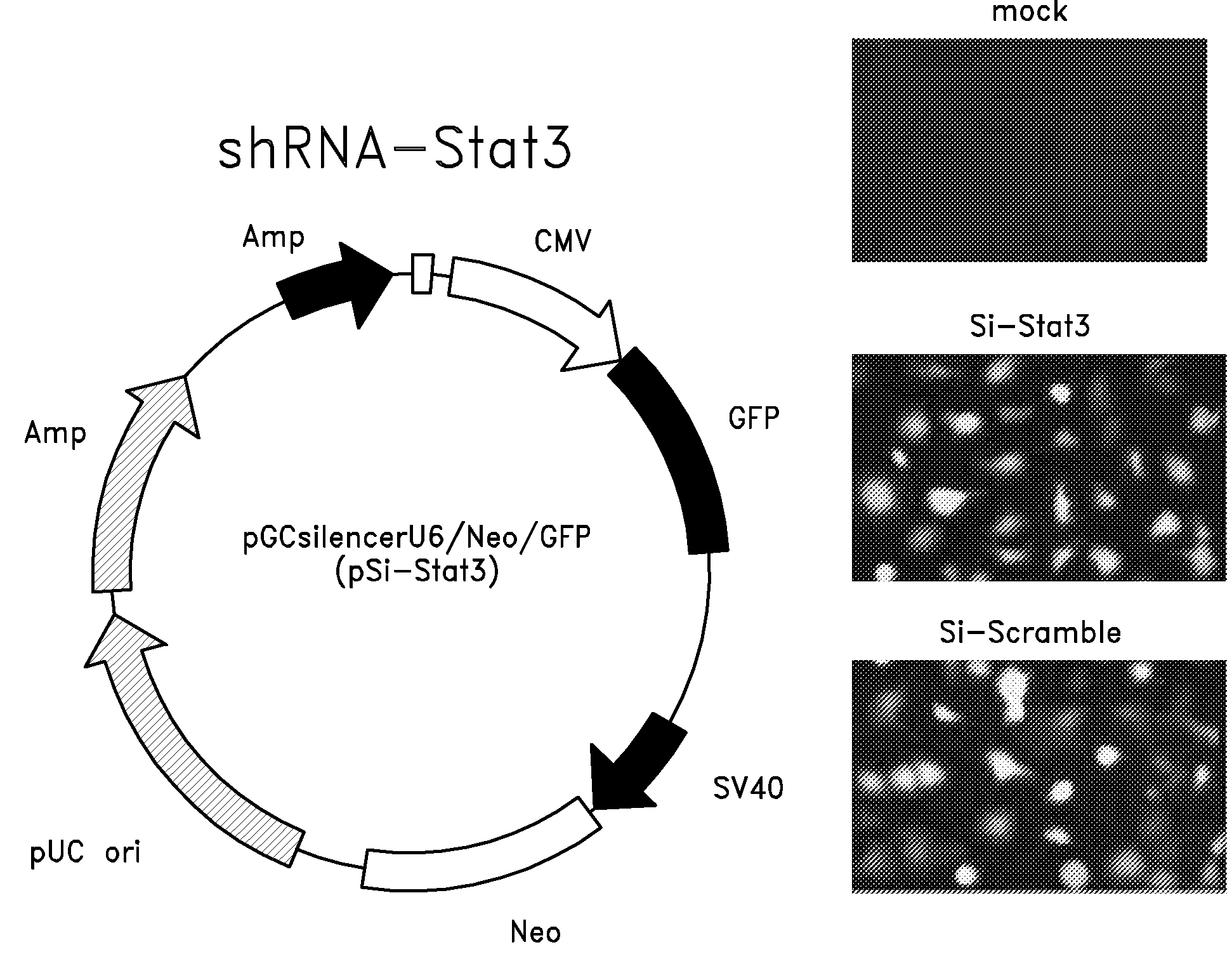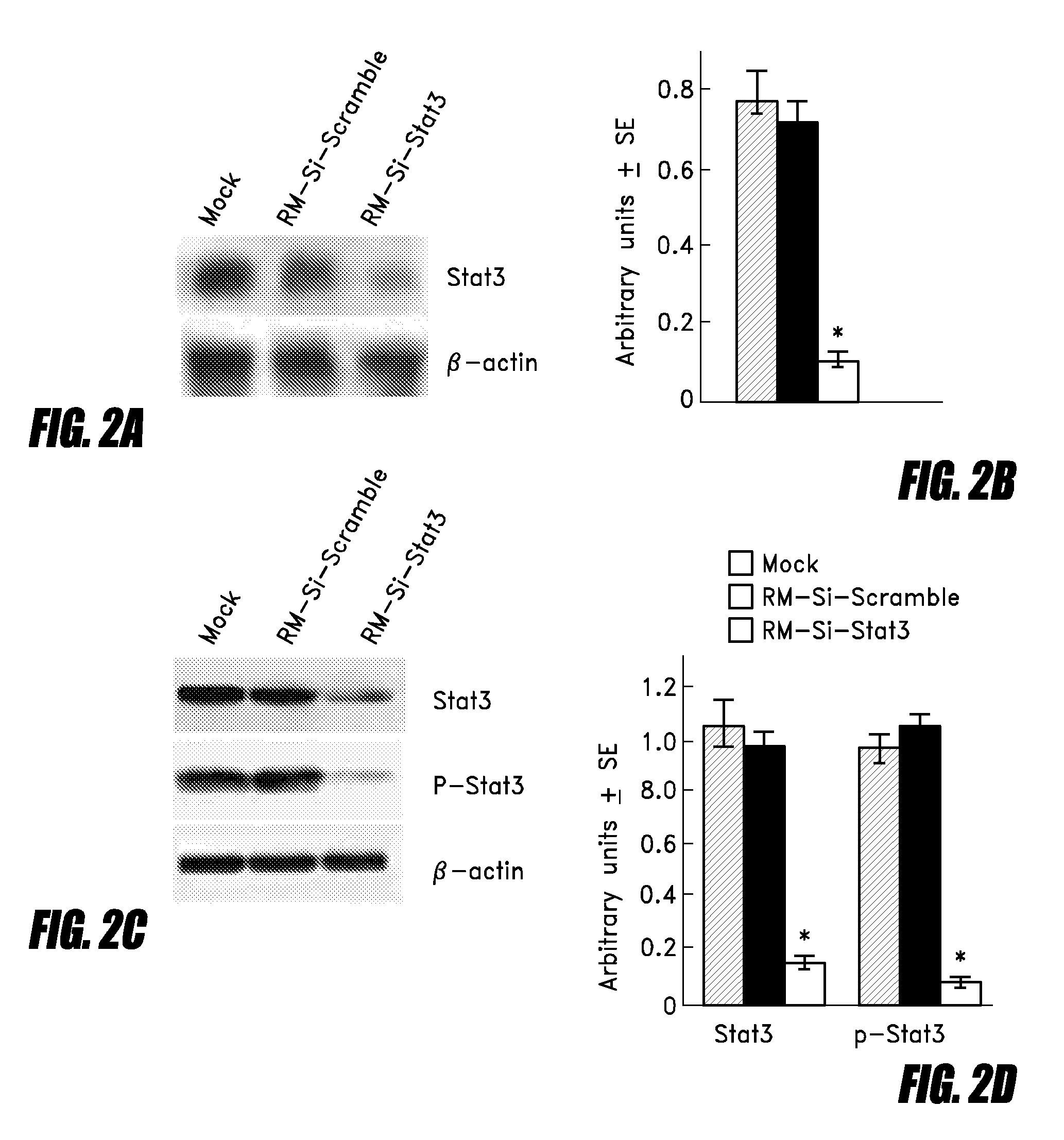[0083]
Signal transducer and activator of transcription 3 (Stat3) is constitutively activated in a variety of cancers and it is a common feature of
prostate cancer. Thus, Stat3 represents a promising molecular target for
tumor therapy. In Gao, L. et al. 2005 Clin
Cancer Res 11:6333-6341), the investigators applied
a DNA vector-based Stat3-specific
RNA interference approach to block Stat3 signaling and to evaluate the biological consequences of Stat3 down-modulation on
tumor growth using a mouse model.
[0025]The
facultative anaerobic, invasive
Salmonella enterica serovar typhimurium (S. typhimurium) has been shown to retard the growth of established tumors. We wondered if a more effective
antitumor response could be achieved in vivo if these
bacteria were used as tools for delivering specific molecular antitumor therapeutics. Constitutively activated
transcription factor signal transducer and activator of transcription 3 (STAT3) promotes the survival of a number of human tumors. In this study, we investigated the relative efficacies of attenuated S. typhimurium alone or combined with Stat3-specific
small interfering RNA (siRNA) in terms of
tumor growth and
metastasis. The
bacteria preferentially homed into tumors over normal liver and
spleen tissues in vivo. S. typhimurium expressing
plasmid-based Stat3-specific siRNAs significantly inhibited
tumor growth, reduced the number of metastastic organs, and extended the
life time for C57BL6 mice bearing an implanted
prostate tumor, versus bacterial treatment alone. These results indicate that attenuated S. typhimurium combined with an
RNA interference approach serve as the basis for the treatment of primary as well as metastatic cancer.
[0025]The
facultative anaerobic, invasive
Salmonella enterica serovar typhimurium (S. typhimurium) has been shown to retard the growth of established tumors. We wondered if a more effective
antitumor response could be achieved in vivo if these
bacteria were used as tools for delivering specific molecular antitumor therapeutics. Constitutively activated
transcription factor signal transducer and activator of transcription 3 (STAT3) promotes the survival of a number of human tumors. In this study, we investigated the relative efficacies of attenuated S. typhimurium alone or combined with Stat3-specific
small interfering RNA (siRNA) in terms of tumor growth and
metastasis. The bacteria preferentially homed into tumors over normal liver and
spleen tissues in vivo. S. typhimurium expressing
plasmid-based Stat3-specific siRNAs significantly inhibited tumor growth, reduced the number of metastastic organs, and extended the
life time for C57BL6 mice bearing an implanted
prostate tumor, versus bacterial treatment alone. These results indicate that attenuated S. typhimurium combined with an
RNA interference approach serve as the basis for the treatment of primary as well as metastatic cancer.
[0035]Our results provide the first convincing evidence that Salmonella can be used for delivering
plasmid-based siRNAs into tumors growing in vivo. The Stat3-siRNAs carried by an attenuated S. typhimurium exhibit tumor suppressive effects not only on the growth of the
primary tumor but also on the development of metastases, indicating that an appropriate attenuated S. typhimurium combined with the RNAi approach serves as the basis of a clinically feasible approach for
cancer therapy. Ultimately, a live, attenuated Salmonella parenteral
delivery system would likely be endotoxic in humans unless an msbB
mutation was introduced, as reported previously (Low, K. B. et al. 1999 Nat Biotechnol 17:37-41).
[0025]The
facultative anaerobic, invasive
Salmonella enterica serovar typhimurium (S. typhimurium) has been shown to retard the growth of established tumors. We wondered if a more effective
antitumor response could be achieved in vivo if these bacteria were used as tools for delivering specific molecular antitumor therapeutics. Constitutively activated
transcription factor signal transducer and activator of transcription 3 (STAT3) promotes the survival of a number of human tumors. In this study, we investigated the relative efficacies of attenuated S. typhimurium alone or combined with Stat3-specific
small interfering RNA (siRNA) in terms of tumor growth and
metastasis. The bacteria preferentially homed into tumors over normal liver and
spleen tissues in vivo. S. typhimurium expressing plasmid-based Stat3-specific siRNAs significantly inhibited tumor growth, reduced the number of metastastic organs, and extended the
life time for C57BL6 mice bearing an implanted prostate tumor, versus bacterial treatment alone. These results indicate that attenuated S. typhimurium combined with an RNA interference approach serve as the basis for the treatment of primary as well as metastatic cancer.
[0025]The facultative anaerobic, invasive Salmonella enterica serovar typhimurium (S. typhimurium) has been shown to retard the growth of established tumors. We wondered if a more effective antitumor response could be achieved in vivo if these bacteria were used as tools for delivering specific molecular antitumor therapeutics. Constitutively activated transcription factor signal transducer and activator of transcription 3 (STAT3) promotes the survival of a number of human tumors. In this study, we investigated the relative efficacies of attenuated S. typhimurium alone or combined with Stat3-specific small interfering RNA (siRNA) in terms of tumor growth and metastasis. The bacteria preferentially homed into tumors over normal liver and spleen tissues in vivo. S. typhimurium expressing plasmid-based Stat3-specific siRNAs significantly inhibited tumor growth, reduced the number of metastastic organs, and extended the life time for C57BL6 mice bearing an implanted prostate tumor, versus bacterial treatment alone. These results indicate that attenuated S. typhimurium combined with an RNA interference approach serve as the basis for the treatment of primary as well as metastatic cancer.
 Login to View More
Login to View More 


